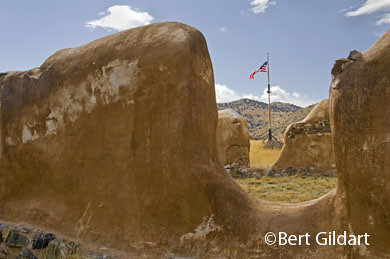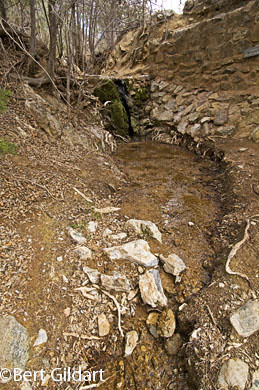Fort Bowie and the Significance of a Tiny Spring
©Bert Gildart: Because of a drenching rain, we remained at Chiricahua National Monument an extra day so that we might make the eight-mile drive into Ft Bowie, all in Arizona. The dirt road over Apache Pass had been rendered almost impassable and if we had driven it the day after the rain, most likely our truck would have been covered with mud and the wheel wells packed with a concrete type mud that is extremely difficult to remove. We’re familiar with Montana gumbo and had been told that Arizona mud reacts similarly.
But now, having made it to Fort Bowie, Janie and I must say that if we had not stayed, knowing what we now know about fascinating old fort, we’d be forever regretful. This small national park-administered area is packed with history from a time in America that has always fascinated us both. Geronimo and Cochise both made their mark here, and so did the Army in pursuit of them both.
APACHE SPRING
Fort Bowie would never have come to exist were it not for Apache Spring, a tiny spring that appeared almost insignificant on the day of our visit. Because of this trickle of water, however, many lost their lives. At first the Apache were tolerant, but after a series of broken promises, trouble began. We learned about this on a three-mile round trip hike, required if you want to visit the site.
Historically, the spring had always been used by the Apache, which is hidden deep in the Chiricahua Mountains, all a part of their historic homeland. Mexico, however, claimed the land, but when Mexico lost a war it transferred land to the United States in 1854 by the Gadsden Purchase. Because of this transaction, the Chiricahua Apaches, who had been living in the region since at least the sixteenth century, experienced a vast increase in traffic. Needing water, pioneer and gold seekers would stop at the spring. To insure their safety, the United States built a military road through Apache Pass. Then Mr. Butterfield received a contract for his Butterfield Overland Mail and that, too, ground its way to over Apache Pass and down into Apache Springs.
BASCOM AFFAIR
For years the Apache tolerated (more or less) the increase in traffic, but the peace did not last. In 1861 a band of Apache to the north of the Cochise’s Chiricahua band kidnapped a young boy. And now enter George N. Bascom, a young Lieutenant fresh out of West Point who shared with General Custer the distinction of having graduated near the bottom of his class. Inviting Cochise to negotiate, Bascom then tried to capture Cochise who grabbed his knife and slashed his way from the tent. Never again would peace rein, and the sad affair became known as the Bascom Affair. [CLICK FOR LARGER IMAGES.]
Soon thereafter (July 1862) Fort Bowie was constructed and in the years that followed it back dropped many clashes, and the graveyard we explored along the trail recalls those times. “Killed by Apache’s” say many of the epitaphs, and one of those marks the grave of O.O. Spence. Spence was one of the earliest recipients of the Medal of Honor.
PROMISES, PROMISES
The fort back dropped the death by natural means of Cochise and then the ascension of Geronimo–and, eventually, his last tragic days as a warrior chief. In 1876 Geronimo surrendered, overwhelmed at last by military technology. He and many other Chiricahua Indians were then shipped by cattle car to Florida. Though promised they’d be allowed to return to their homeland within two years, they were held for over 20 years as enemy combatants. Eventually, they were shipped to Fort Sill, Oklahoma, where in 1909 Geronimo died of pneumonia at approximately (records are scant) 84 years of age.
That’s the story that unfolds as you hike the trail and then linger at the old fort, finally abandoned in 1894. With its old adobe walls the fort is photogenic and we explored it until diminishing daylight necessitated our return.
__________________________
THIS TIME LAST YEAR:
*Marta Becket’s Amargosa Opera House





